30 setembro 2013
as actividades em livro
Está já disponível o livro electrónico "As borboletas da floresta amarela", onde encontra a descrição completa das actividades e sugestões para as explorar em diferentes contextos. O livro é disponibilizado gratuitamente, sob licença Creative Commons.
Para descarregar o pdf do livro, carregue aqui.
[se pretender imprimir em alta resolução os cartões da actividade sobre sistemática e montá-los num suporte semi-rígido, carregue aqui]
-
Uma versão resumida das mesmas actividades foi publicada na revista científica de acesso livre Evolution: Education and Outreach. O artigo pode ser lido aqui.
24 setembro 2011
as actividades na NEI 2011
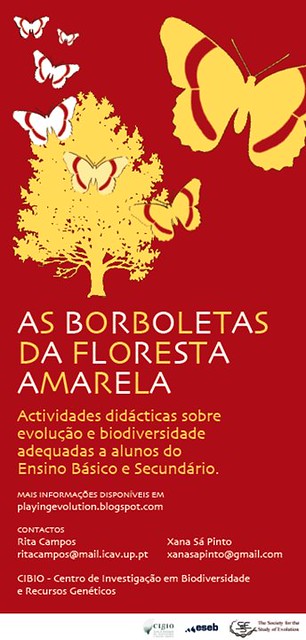
Realizou-se ontem mais uma edição da Noite Europeia dos Investigadores (NEI). No Porto, a área destinada às actividades "mão-na-massa" esteve sempre muito animada, contando com muitas visitas organizadas por escolas e com muito público que ou já conhecia a iniciativa ou estava de passagem.
Para podermos estar sempre disponíveis a esclarecer conceitos ou simplesmente descansar por uns minutos, contámos com a ajuda preciosa de uma estudante do secundário que no ano lectivo passado participou nas sessões que organizámos na Escola Sec. Rodrigues de Freitas.
Foi muito gratificante ver tantas pessoas, de idades tão variadas, a mostrarem interesse pelas actividades e pelas discussões que se geram à sua volta. Mas foi com especial satisfação que recebemos as visitas de algumas das crianças que trabalharam connosco no ano lectivo passado e que não só fizeram questão de nos ir cumprimentar como levaram os pais e irmão para conhecerem (e jogarem) as actividades.


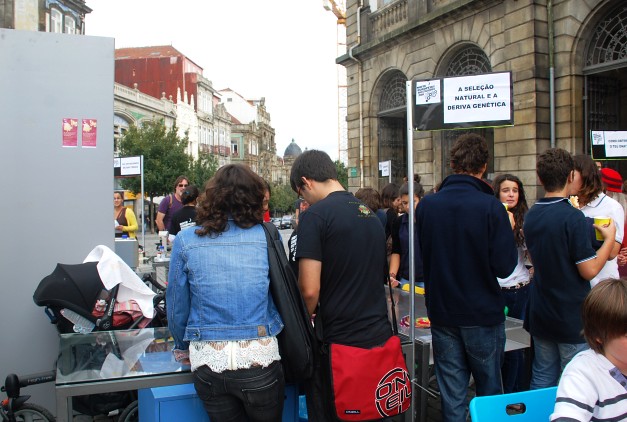
11 setembro 2011
Noite Europeia dos Investigadores 2011 | Researchers' Night 2011
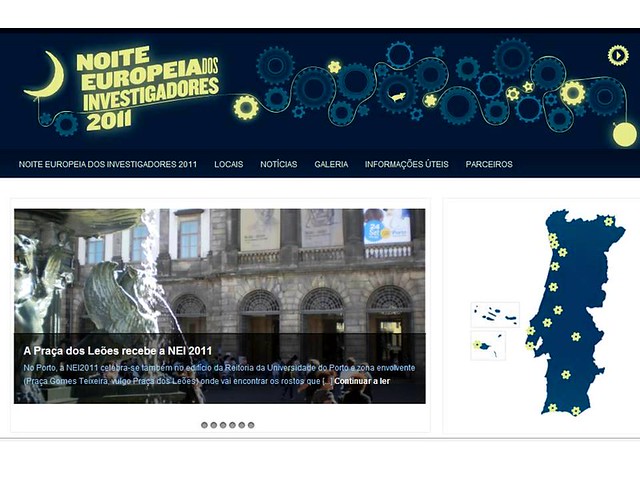
A Noite Europeia dos Investigadores (NEI) permite a cientistas e público geral conviverem num ambiente descontraído. A troca de ideias e experiências que a NEI proporciona pretende contribuir para a construção de uma imagem mais saudável dos investigadores junto do público e demonstrar que, afinal, a ciência não é tão complicada quanto se julga.
Iremos estar presente com as actividades sobre selecção natural e deriva genética, na Praça Gomes Teixeira ("Praça dos Leões"), das 15h às 20h. Contamos com a vossa visita!
...
The Researchers' Night is a Europe-wide event bringing together the public at large and researchers (...). During the Researchers' Night you will have the chance to discover research facilities that are usually not open to public (laboratories, research centres, museum collections ), to use the most recent technologies and instruments with the guidance of scientists, to participate in experiments, competitions and quizzes, to watch demonstrations and simulations, to exchange ideas and to party with the researchers. For one night, everyone can be a scientist.
We will participate with the activities about natural selection and genetic drift. Hope to see you there!
06 maio 2011
Férias com a teoria da evolução | Holidays with the theory of evolution
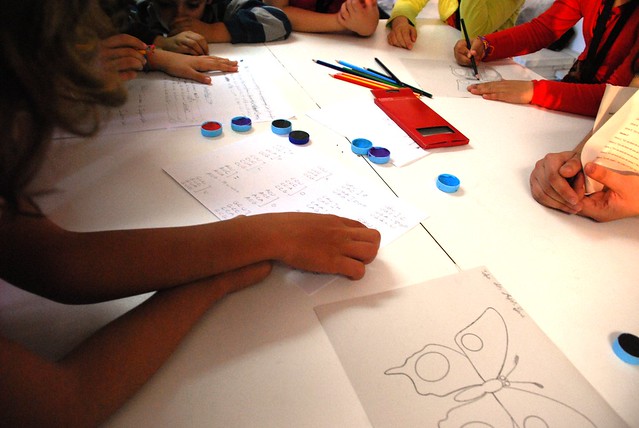

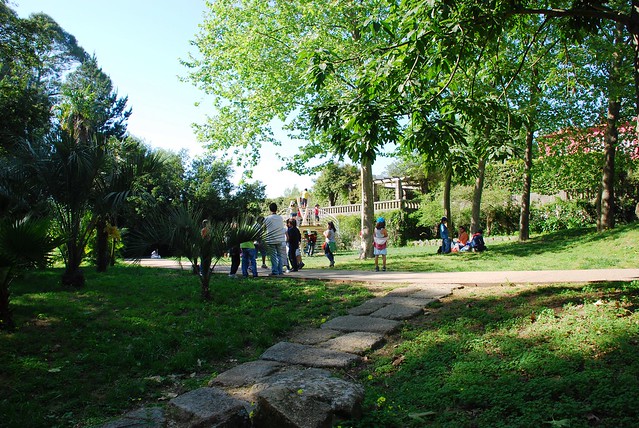
Nas férias escolares 22 crianças com idades compreendidas entre os 6 e os 10 anos e 15 com idades entre os 11 e os 12 anos passaram uma semana na exposição “A Evolução de Darwin”. Através de várias actividades didácticas, tiveram oportunidade de conhecer melhor os conteúdos da exposição, desde a molécula que torna todos os seres vivos membros de uma só família -o ADN (sigla para ‘Ácido DesoxirriboNucleico’)- aos complexos mecanismos que promovem a divergências das populações (e que por isso poderão abrir caminho à formação de novas espécies).
Em cinco dias solarengos, os participantes foram cientistas, exploradores, artistas plásticos, escritores e actores. Comeram numa cantina universitária, brincaram na escada/escorrega do ADN/RNA, conheceram os animais das estufas e aproveitaram o bom tempo nos espaços abertos do Jardim Botânico.
Aos monitores da exposição - e em particular ao Guilherme, à Isabel Bessa e ao João “Cão”-, ao professor Joaquim Parreira e às monitoras do Jardim Botânico Joana Marques, Joana Torres e Estefânia Lopes, o nosso muito obrigada pela ajuda!
...
During de school holidays 22 children with ages between 6 and 10 years and 15 with ages between 11 and 12 years spent a week in the exhibition “Darwin’s Evolution”. using didactic activities, they had the opportunity to know better the contents of the exhibition, from the molecule that makes all living beings members of the same family - DNA (from ‘DeoxyriboNucleic Acid’)- to the complex mechanisms that promote populations’ divergence (and thus can promote the origin of new species).
In five sunny days, the children were scientists, explorers, plastic artists, writers and actors. They ate at a university canteen, played in the DNA/RNA slide, met the animals from the greenhouses and enjoyed the nice weather in the open spaces of the Botanical Garden.
To the exhibition monitors -particularly to Guilherme, Isabel Bessa and João “Cão”-, to teacher Joaquim Parreira and to the Botanical Garden monitors Joana Marques, Joana Torres and Estefânia Lopes, thank you very much for the help!

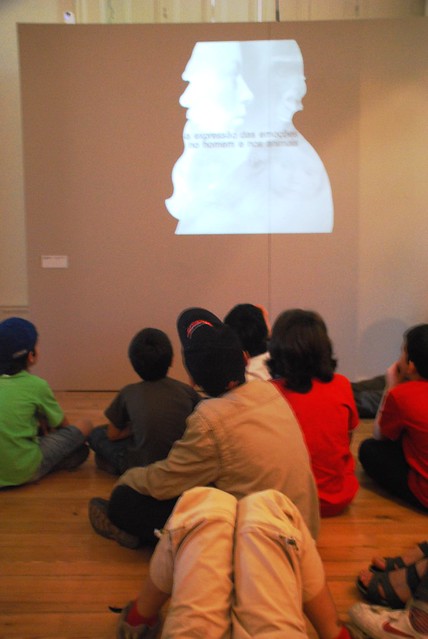
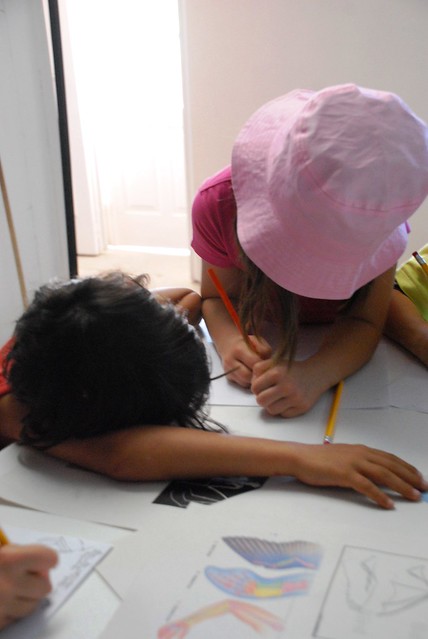
08 abril 2011
Escola Secundária Rodrigues de Freitas | High School Rodrigues de Freitas
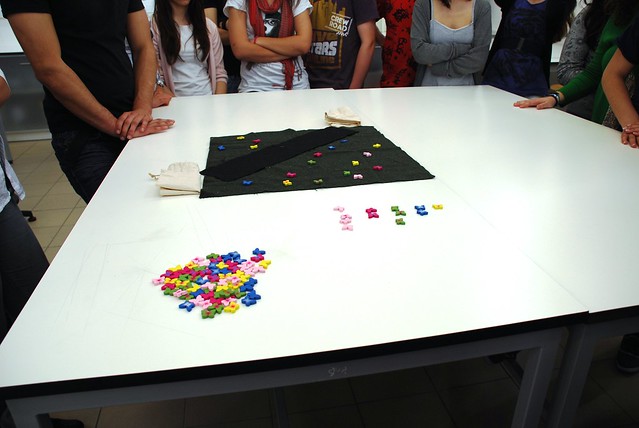
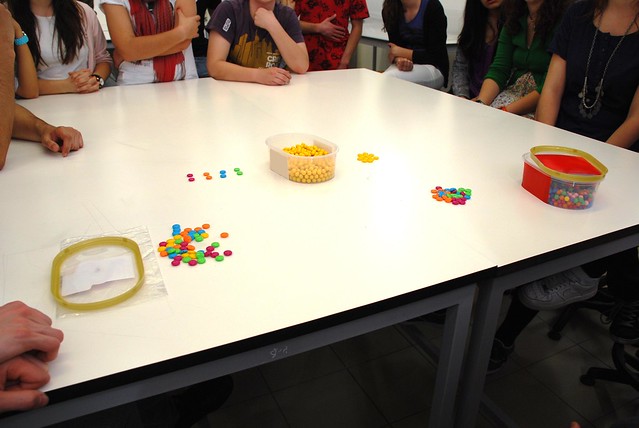
Visita à Escola Secundária Rodrigues de Freitas para participar na Semana da Ciência.
A convite da professora Helena Ribeiro, estivemos das 10h às 13h com duas turmas do 11º ano com as actividades sobre selecção natural e deriva genética. O objectivo desta participação foi complementar os conteúdos programáticos sobre evolução e estimular a discussão sobre a importância dos mecanismos evolutivas no estudo da biodiversidade e suas aplicações práticas.
...
Visit to the High School Rodrigues de Freitas to participate in the Science Week.
Teacher Helena Ribeiro invited us to spend the morning (from 10am to 1pm) with students from two classes in the 11th grade. The activities about natural selection and genetic drift were used in order to complement the principles of evolution taught during this school year and to promote a discussion about the importance of the knowing about the evolutionary mechanisms in the study of biodiversity and their practical applications.
06 abril 2011
sistemática | systematics
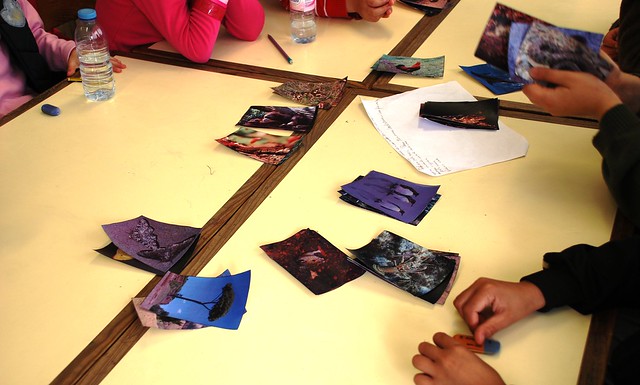
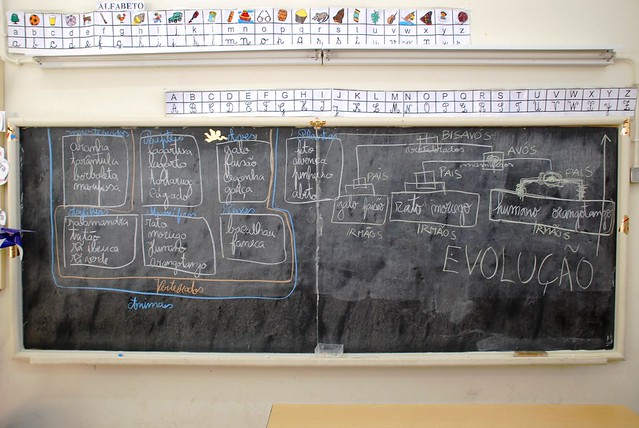
Com esta actividade pretende-se que os alunos adquiram a noção da diversidade de espécies existentes no planeta, das diferenças e semelhanças que existem entre estas e percebam que as suas características reflectem a sua história evolutiva.
Para tal, os alunos foram convidados a formar grupos de espécies de acordo com as suas características e a justificar as suas escolhas. Foram depois convidados a agrupar os grupos anteriormente formados e a repetirem este processo até ficarem com um único grupo. Os agrupamentos feitos pelos alunos foram posteriormente representados no quadro sob a forma de árvore.
Os alunos estabeleceram de imediato a ligação entre a árvore produzida pelos agrupamentos hierárquicos e uma árvore genealógica. Após a discussão gerada por esta comparação, os alunos foram capazes de perceber que as semelhanças entre as espécies reflectem o seu grau de parentesco evolutivo e o tempo passado desde o ancestral comum entre ambas. Neste âmbito, discutiu-se ainda de que forma os mecanismos de selecção natural e deriva genética poderiam produzir duas espécies distintas a partir de uma mesma espécie.
...
This activity was developed so that students could understand that the diversity of species that we nowadays observe results from a long process of evolution and that their features reflect their evolutionary history.
In order to achieve these goals, photos from several animal and plant species were presented to the students and they were asked to form groups of two species that were more similar to each other than to any other species. The rationale for forming each group were discussed with the entire class and registered. The students were then asked to make groups of the previously formed groups using the same grouping criteria. This procedure was repeated until all the species were joined in a single group. This hierarchical grouping was represented as an evolutionary tree and the students were then asked about the reason for the hierarchical distribution of species similarities.
The students immediately compared the evolutionary tree drawn to the genealogical trees they had already drawn and this comparison allowed them to understand that the species similarities depended on the time passed since they shared their last common ancestral. The evolution and divergence of species through time and the role of genetic drift and natural selection on this process was then explained and discussed with the students.
13 março 2011
férias escolares com "A evolução de Darwin" | school vacations with "Darwin's Evolution"
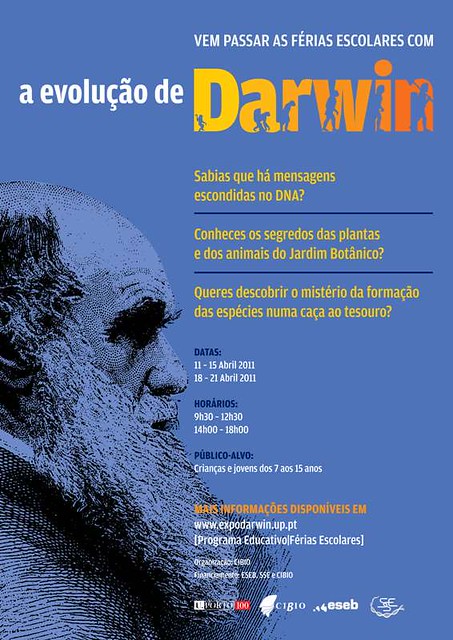
Programa dirigido a crianças e jovens, dos 7 aos 15 anos. Inclui possibilidade de almoço na cantina da Faculdade de Ciências da Universidade do Porto.
Inscrições e mais informações no site da exposição "A Evolução de Darwin" no Porto, no separador 'Programa Educativo|Férias Escolares'.
...
Activities developed to children aged 7 to 15 years old, with the possibility of having lunch in the canteen of the Faculty of Sciences, Univerisity of Porto.
Registrations and further informations are available at the site of the exhibition "Darwin's Evolution", under 'Programa Educativo|Férias Escolares' (portuguese only).
09 março 2011
deriva genética - avaliação da actividade | genetic drift - evaluation of the activity
Para avaliar o sucesso da actividade sobre Deriva Genética, elaborou-se uma ficha com um novo cenário, representando a colonização de dois novos habitat feitas a partir de números iniciais de indivíduos muito diferentes. Os alunos foram capazes de prever onde esperariam encontrar maiores níveis de diversidade com base no tamanho esperado das populações.
...
The activity about genetic drift was evaluated by asking students to predict levels of intraspecific diversity in two new recently occupied habitats, one larger and with more individuals and one smaller and with fewer individuals. Students were able to predict where they would expect to find higher levels of diversity based on the expected population size.
19 fevereiro 2011
deriva genética e impacto das acções humanas na diversidade intraespecífica | genetic drift and impact of human actions on intraspecific diversity
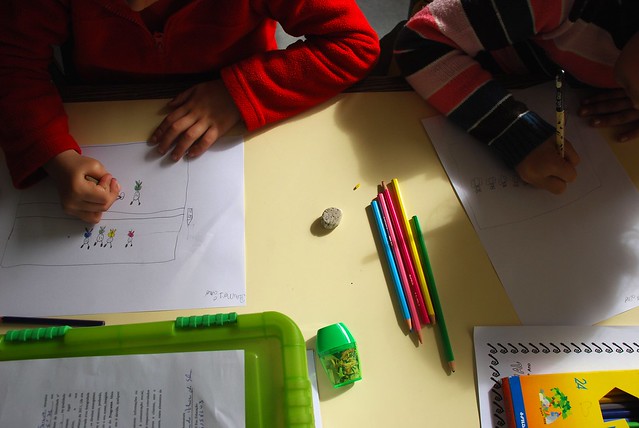
Com esta actividade pretende-se que os participantes percebam o mecanismo de evolução por deriva genética, o seu impacto na composição genética das populações e de que forma pode causar divergência entre populações/espécies. Pretende-se ainda que os participantes se apercebam dos impactos que as actividades humanas podem ter na diversidade genética de uma espécie.
Tal como a actividade sobre Selecção Natural, esta actividade também tem vindo a ser testada em vários contextos e para vários tipos de público, tendo sido já levada a cabo para o público em geral, no âmbito de uma exposição realizada para comemorar o “Ano Darwin”, para estudantes de secundário, no âmbito da Mostra da Universidade do Porto, Euroskills e em salas de aula, e para alunos de escolas primárias. Irá também estar disponível na exposição “A Evolução de Darwin”, a inaugurar brevemente na Casa Andresen, Jardim Botânico do Porto.
Para introduzir esta actividade nas escolas primárias foi proposto aos alunos que previssem o impacto na diversidade e composição genética de uma população de borboletas com diversidade de cor devido à fragmentação do seu habitat (representado por um pano verde) em duas partes de diferentes tamanhos, devido à construção de uma autoestrada (representada pela pano preto). Depois de simularem a construção da autoestrada os alunos simularam ainda vários ciclos de reprodução e sobrevivência aleatória em cada uma das duas novas populações.
Antes de realizarem a actividade apenas uma pequena parte dos alunos das diferentes classes foram capazes de prever a perda mais acentuada de diversidade genética na população de menor tamanho. Após a realização da actividade os alunos perceberam que, em relação à população inicial, as duas populações alteraram a sua composição genética ao longo tempo e perderam diversidade devido ao acaso, sendo esta perda de diversidade genética inversamente proporcional ao tamanho da população. Os alunos perceberam ainda que, ao contrário do que ocorria na actividade da evolução por selecção natural, a realização desta actividade várias vezes poderia conduzir a diferentes resultados em termos da composição genética das populações, dada a aleatoriedade do processo.
Foi ainda discutido o impacto da fragmentação do habitat para a manutenção da diversidade genética das populações e sua consequente sobrevivência a longo prazo.
...
This activity was designed to make students understand how the genetic composition of a species may change due to random factors and how genetic drift may affect intraspecific diversity and cause species/populations divergence.
In order to achieve this goal we asked the students to predict the impact of a construction of a road (represented by the black cloth strip) on a population of butterflies (represented by the wood butterflies with colour diversity) initially distributed on the previously continuous habitat (represented by the green cloth). After drawing their predictions, students played the game. They randomly distributed the butterflies (six butterflies per each of the five distinct colours) on the continuous habitat and then divided this habitat in two patches of different sizes. Random survival and reproduction (represented by the blind choice of individuals from an opaque bag) was simulated several times for each of the two recently separated populations and all the results were registered.
After this activity, the students were able to understand that the two populations evolved through time becoming different from each other and from the initial population only due to random factors. They also noticed that both populations lost genetic diversity, and that the extent of the diversity loss was negatively correlated with the size of the population.
Finally the students were also able to understand that human activities that cause habitat fragmentation and that decrease populations’ sizes deeply impact the intraspecific diversity of the species.


31 janeiro 2011
selecção natural - avaliação da actividade | natural selection - activity evaluation
...
To evaluate whether the activity regarding natural selection was able to achieve its goals and if students were able to apply the concept in a new context we visited each class once more and ask the students to predict what would happen to an insular population of birds with distinct flights abilities after the introduction of cats. The vast majority of the students were able to correctly predict the expected result and to explain it as the outcome of differential survival and reproduction of the distinct types of bird.
23 janeiro 2011
selecção natural e a importância da preservação da biodiversidade | natural selection and the importance of intraspecific biodiversity

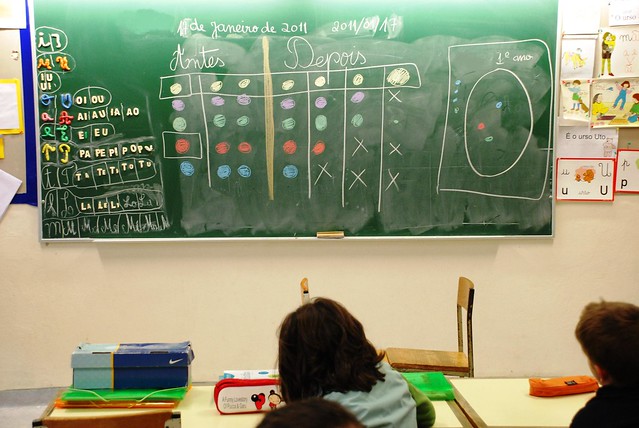
Com esta actividade pretende-se que os participantes percebam o mecanismo de evolução por selecção natural e a importância da preservação da biodiversidade intra-específica para a sobrevivência das espécies a longo prazo.
Esta actividade tem vindo a ser testada em vários contextos e para vários tipos de público, tendo sido já levada a cabo para o público em geral, no âmbito de uma exposição realizada para comemorar o “Ano Darwin”, para estudantes de secundário,no âmbito da Mostra da Universidade do Porto, Euroskills e em salas de aula, e para alunos de escolas primárias. Irá também estar disponível na exposição “A Evolução de Darwin”, a inaugurar brevemente na Casa Andresen, Jardim Botânico do Porto.
Nas escolas primárias, para introduzir esta actividade começou-se por contar aos alunos a história das borboletas da floresta amarela. De acordo com esta história, numa floresta com grande diversidade de plantas de cores diferentes (representada pela caixa cheia de contas de colar de cores diversas) existia uma espécie de borboletas com elevada diversidade genética (representada pelas “pintarolas” de plástico de 5 cores diferentes) e que era predada por pássaros (representados pelos participantes). Para que os alunos percebessem de que forma a predação afectava a espécie foi-lhes permitido caçarem na floresta com diversidade de cores. Mais tarde, a construção de uma fábrica de tinta amarela numa área próxima dessa floresta fez com que todas as plantas ficassem cobertas de um pó amarelo (representada pela caixa cheia de contas de colar amarelas). Perguntou-se então aos alunos o que achavam que iria acontecer às borboletas da floresta.
Antes de realizarem a actividade apenas uma pequena parte dos alunos das diferentes classes foram capazes de prever o resultado desta experiência. Após a realização da actividade os alunos perceberam que a população evoluía por selecção natural, adaptando-se ao novo meio e perceber e explicar de que forma este mecanismo evolutivo poderia conduzir à divergência de populações sujeitas a condições ambientais distintas.
Colocando a população final, cuja diversidade ficou reduzida à cor amarela, num meio diferente (representada pela caixa cheia de contas de colar verdes) permitiu que os alunos concluíssem que a manutenção de níveis elevados de diversidade genética é fundamental para garantir a sobrevivência das espécies.
...
This activity was designed to make students understand how the genetic composition of a species may change due to natural selection and how this mechanism affects intraspecific diversity and may cause species/populations divergence.
In order to do this we began the activity by telling the story of the “butterflies from the yellow forest”: a species of butterflies with wing colour diversity (represented by flattened plastic beads of 5 colours) inhabited a forest with a great diversity of plants (represented by the box filled with colourful plastic pearls) and were preyed by birds (represented by the students); one day a yellow ink factory was constructed near that forest and released a yellow dust that covered the plants (represented by a box filled with yellow plastic pearls). The question was: what is going to happen to the butterflies? We first allowed the students to prey butterflies in the diverse habitat and the non‐preyed butterflies were able to reproduce so that they could understand how the game worked. Each student then drew the predicted results on the yellow forest and only after that they were allowed to prey on this habitat and observe the evolution of the preyed species.
Before this activity only a small fraction of the students were able to correctly predict the expected results. At the end of the game the students were able to understand that the butterflies’ population evolved through time and became adapted to the new environment. They also understood that this evolution and adaptation was due to the fact that the yellow butterflies were much less preyed in the new habitat, surviving more and having more descents.
The yellow butterflies were then placed in a different habitat (represented by the box filled with green plastic pearls) to help students understand that human activities impact on intraspecific diversity and that genetic diversity is important to species’ survival rates.
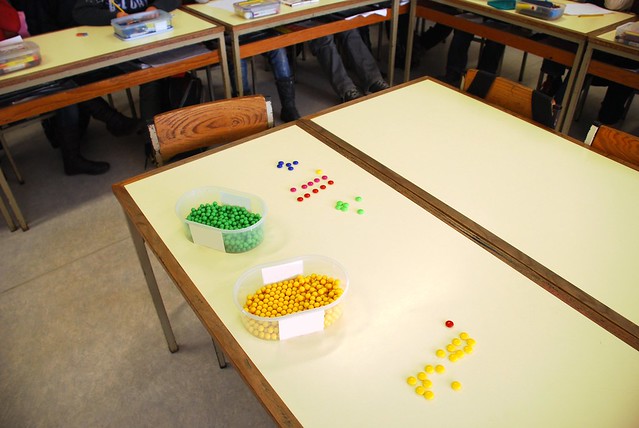
05 janeiro 2011
Escola Secundária Gonçalves Zarco | High School Gonçalves Zarco
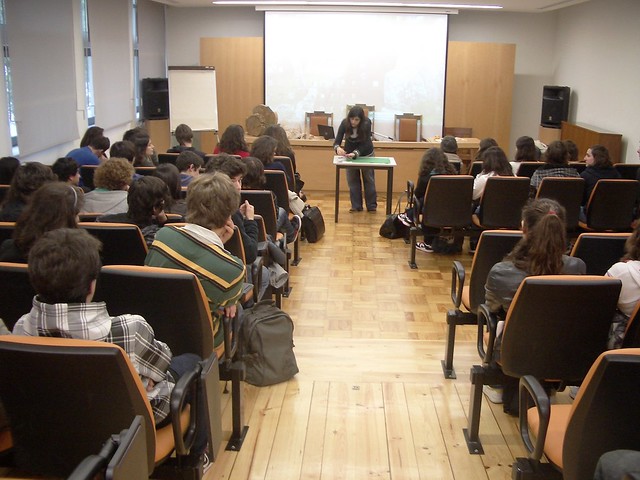
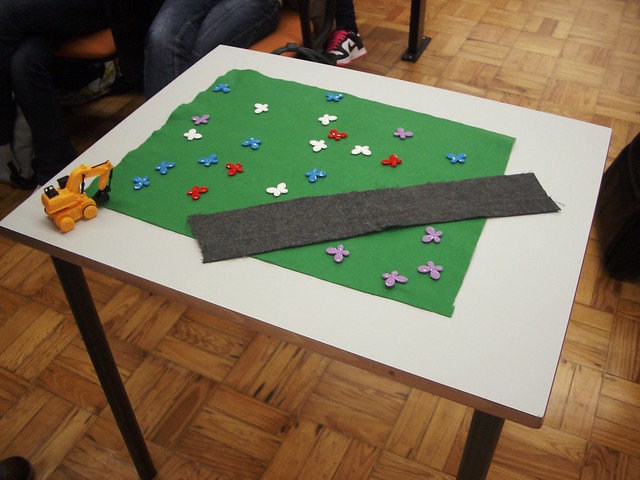
Visita à Escola Secundária Gonçalves Zarco, a convite do professor Ricardo Andrade, para divulgar os trabalhos de investigação realizados no CIBIO e motivar os alunos para a importância do estudo da evolução biológica, usando as actividades sobre selecção natural e deriva genética.
A sessão realizou-se entre as 14h30 e as 18h e contou com cerca de 50 alunos do 11º ano.
...
Teacher Ricardo Andrade invited us to visit the High School Gonçalves Zarco to talk about research done in CIBIO and to motivate students to the importance of studying evolution, for which we used the activities about natural selection and genetic drift.
The session was done from 2.5pm to 6pm and about 50 students from the 11th grade were present.
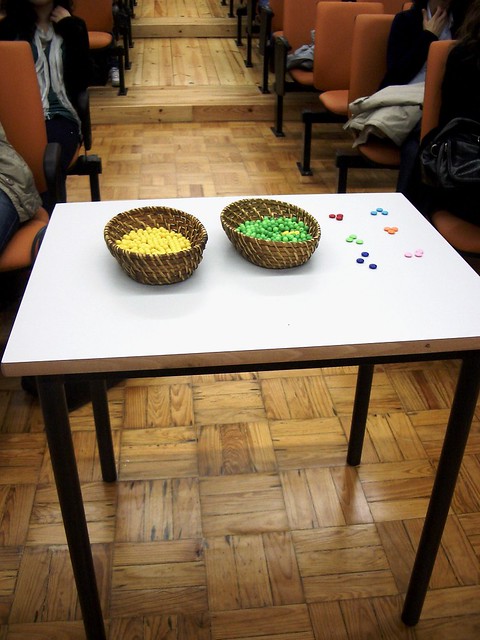
18 dezembro 2010
diversidade intraespecífica e hereditariedade | intraspecific diversity and heredity
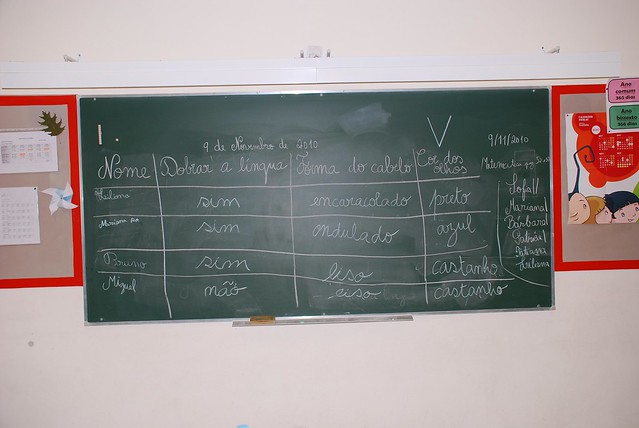

Com esta actividade pretende-se que as crianças se apercebam da existência de diversidade intra-específica e de como esta diversidade se transmite ao longo das gerações.
Esta actividade foi dividida em duas aulas distintas. Numa os alunos identificaram diversidade intra-específica na espécie humana e na outra os alunos analisaram os mecanismos de transmissão genética.
Os alunos identificaram várias características humanas para as quais se observa diversidade tais como a cor dos olhos, pele e cabelo, altura, forma dos olhos, do nariz e da cara, forma do cabelo (liso, ondulado, encaracolado), presença/ausência de covas no queixo e nas bochechas, capacidade de dobrar ou não a língua, presença/ausência de sardas, etc. Os alunos foram ainda capazes de identificar biodiversidade intra-específica em outras espécies de seres vivos (geralmente animais domésticos como cães, gatos e galinhas).
Partindo da análise das suas próprias árvores genealógicas e/ou de árvores genealógicas fornecidas, os alunos foram igualmente capazes de compreender que muita da diversidade genética que se observa na espécie humana (e em outras espécies) é transmitida ao longo das gerações, que na maior parte dos casos as características não se encontram associadas e compreender o mecanismo de transmissão hereditária mendeliana e os conceitos de recessivo e dominante.
...
The present activity was designed to make students notice the existence of hereditary intraspecific diversity and to make them understand some basic hereditary principles. Two visits to each class were necessary to accomplish these goals.
In the first visit we asked the students to identify features that showed diversity within human species. The students were able to identify several features that show diversity within humans. We then make them notice that for some of these features (like skin colour and height) the phenotypes showed a continuous distribution while others (like the presence/absence of a cleft chin) displayed a discrete distribution. We then asked the students to make a draw from themselves that depicted all the features that were identified by them as showing intraspecific diversity.
During the second visit we explored a human genealogical tree in order to make them notice that: i) the features of a child are inherited from their parents; ii) each child always receives two information for the same feature: one from the mother and one from the father; iii) that the inheritance of a given phenotypic character was independent from the inheritance of another character; iv) that some information behaves like dominant and some like recessive. Some students brought pictures of their close relative and thus the information of their own genealogical trees was also used to demonstrate these mechanisms. A mother‐son‐possible fathers’ “trio” was used to further explore the concepts thought in both visits and to test the efficacy of the activity.
13 dezembro 2010
Euroskills Lisboa 2010
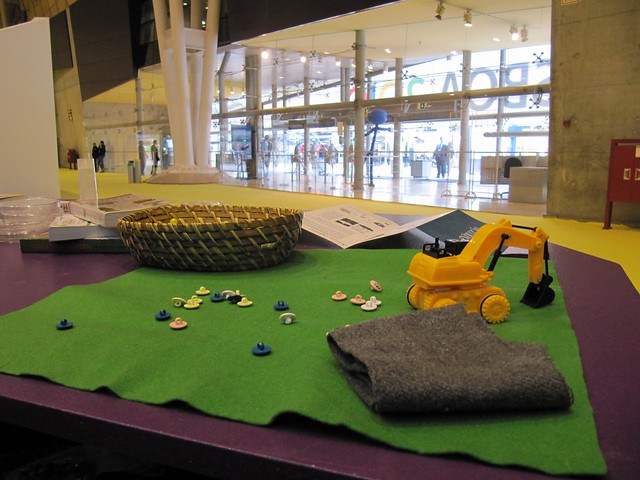
O CIBIO esteve presente no Campeonato Europeu das Profissões - Euroskills Lisboa 2010 - e as actividades sobre Deriva Genética e Selecção Natural ajudaram a explicar a importância da investigação em Biodiversidade e Evolução.
Obrigada à Inês Montalvão e restante equipa por nos representarem neste evento e pela partilha das fotografias.
...
CIBIO was present at the European Champion of Professions - Euroskills Lisboa 2010 - and the activities about genetic drift and natural selection help to explain the importance of doing research in Biodiversity and Evolution.
Thank you Inês Montalvão and rest of the team for representing us in this event and for sharing these photographs with us.
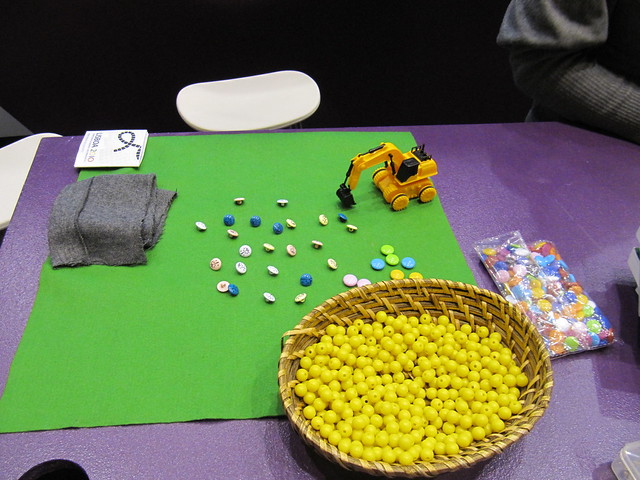
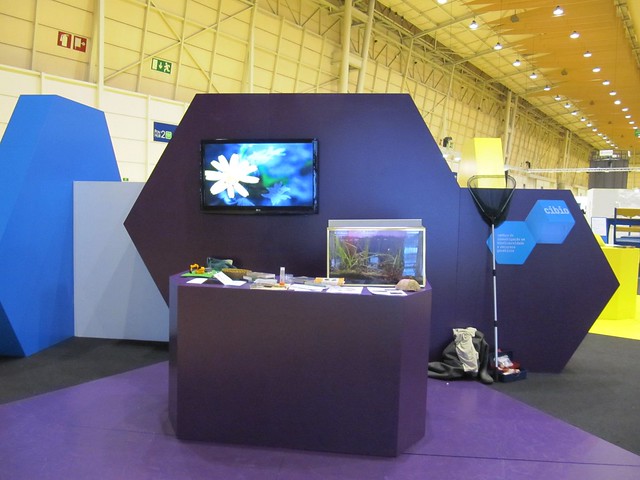
13 outubro 2010
actividades sobre evolução e biodiversidade | activities about evolution and biodiversity
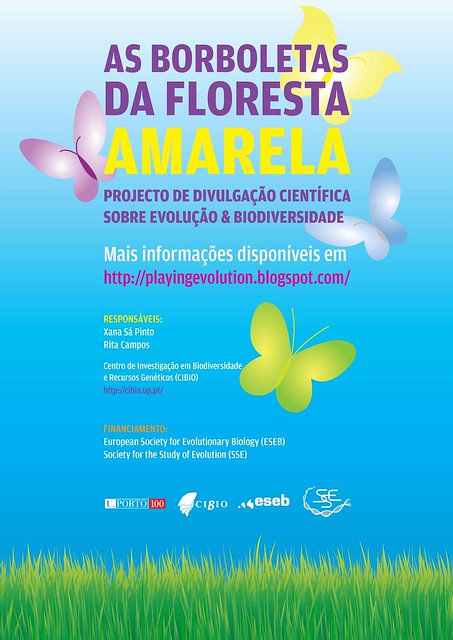
Dois projectos de divulgação científica em escolas do 1º Ciclo do Ensino Básico serão financiados por duas sociedades de biologia evolutiva internacionais, os projectos Evolving Evolutionary Thoughts, financiado pela Sociedade Europeia de Biologia Evolutiva (ESEB), e Nothing in Biodiversity Makes Sense Except in the Light of Evolution, financiado pela Sociedade para o Estudo da Evolução (SSE).
O conjuntos das actividades incluídas nestes projectos irão ser desenvolvidas durante o ano lectivo de 2010/2011 em duas Escolas EB1, uma do Porto e outra do concelho de Mangualde, e irão igualmente fazer parte da disciplina de Área de Projecto de uma turma do 9º ano de uma Escola EB23 do concelho de Resende.
No ano de 2011 duas destas actividades -sobre os mecanismos evolutivos deriva genética e selecção natural- irão ainda estar disponíveis para as visitas guiadas à exposição "A Evolução de Darwin", que estará patente na Casa Andresen, Jardim Botânico do Porto. A organização desta exposição no Porto está a cargo do CIBIO e integra-se no programa de comemorações do Centenário da Universidade do Porto.
Para mais informações, contactar as investigadoras responsáveis, Rita Campos e Xana Sá Pinto.
...
Two outreach projects for Elementary Schools will be financed by two international evolutionary biology societies, the project Evolving Evolutionary Thoughts, financed by the European Society of Evolutionary Biology (ESEB), and Nothing in Biodiversity Makes Sense Except in the Light of Evolution, financed by the Society for the Study of Evolution (SSE).
The activities included in both projects will be developed during the next school year (2010/2011) in two Elementary Schools, one located in the city of Porto and the other in the county of Mangualde, and will also be part of the discipline Project ('Área de Projecto'), from the 9th grade, of student from one class from a School in the county of Resende.
During part of 2011 two of these activities - about the evolutionary mechanisms of genetic drift and natural selection- will also be available to the guided visits to the exhibition "Darwin's Evolution", that will be held in Casa Andresen, Botanical Garden of Porto. CIBIO is leading the organization of this exhibition in Porto; this exhibition is also part of the celebration of the Centenary of the University of Porto.
For further information, please contact the principal investigators, Rita Campos and Xana Sá Pinto.
24 julho 2010
Ocupação Científica no Verão | Scientific Occupation in the Summer
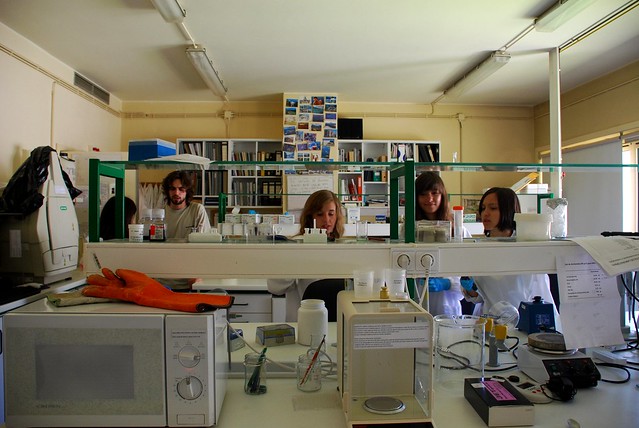
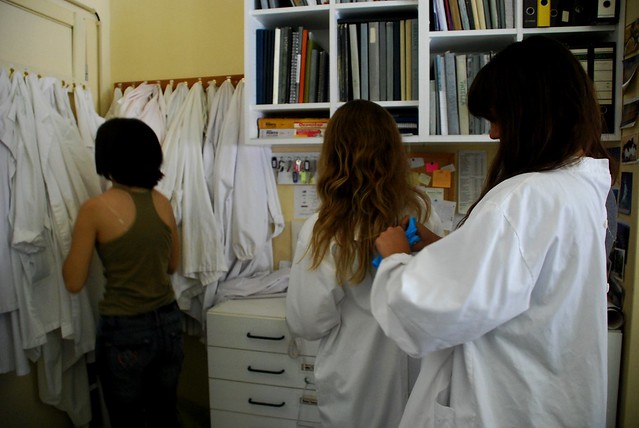
Três estudantes do Ensino Secundário passaram duas semanas nos laboratórios do CIBIO, em Vairão, a conduzir uma investigação sobre a evolução de um organismo marinho, a lapa (Patella spp).
Esta actividade fez parte do programa Ciência Viva - Ocupação Científica no Verão.
...
Three High School students spent two weeks at the CIBIO laboratories in Vairão conducting a research about the evolution of a marine organism, the limpet (Patella spp).
This activity was part of the Ciência Viva program - Scientific Occupation in the Summer.

21 maio 2010
EB 2,3 Sophia de Mello Breyner | School Sophia de Mello Breyner
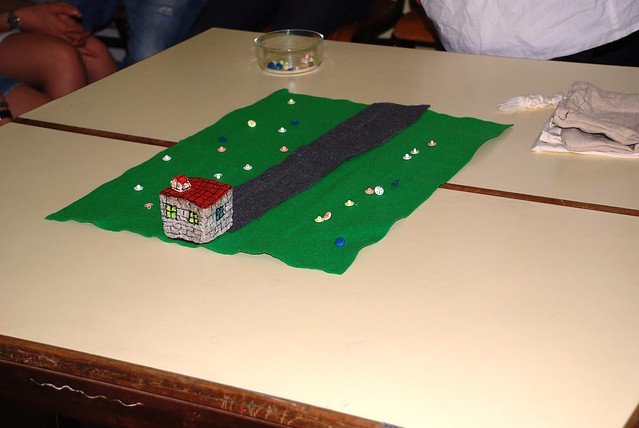
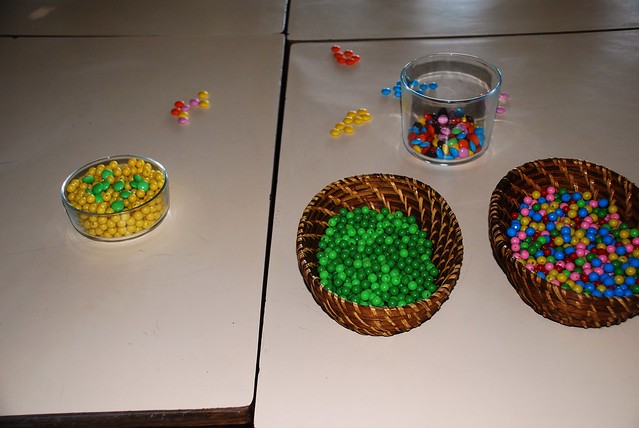
Visita à Escola EB 2,3 Sophia de Mello Breyner, Vila Nova de Gaia, para participar nas Comemorações do Dia Mundial da Biodiversidade.
Das 10h15 às 18h, estivemos com três turmas do 7º ano, quatro do 8º ano e uma turma do 9º ano. As actividades que demonstram os mecanismos evolutivos de Selecção Natural e Deriva Genética foram o ponto de partida para debates sobre biodiversidade, diversidade genética, especiação, impacto das acções humanas, adaptação, extinção ou as diferentes valências de um biólogo.
Aqui, a nossa visita no blogue da escola.
...
We were invited to visit the School Sophia de Mello Breyner, in Vila Nova de Gaia, to participate in the Celebrations of the International Day for Biological Diversity.
From 10.15am to 6pm we were with three classes from the 7th grade, four classes from the 8th grade and one class from the 9th grade. The activities that demonstrate the evolutionary mechanisms of natural selection and genetic drift served as the starting point for many debates about biodiversity, genetic diversity, speciation, the impact of human actions, adaptation, extinction and also about the different areas where a biologist can work.
Here, our visit in the school blog.

29 março 2010
8ª Mostra de Ciência, Ensino e Inovação da Universidade do Porto | 8th Exhibition about Science, Education and Inovation from the University of Porto
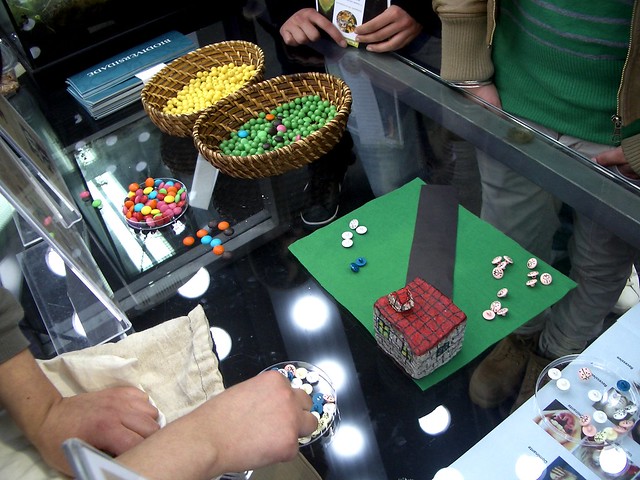
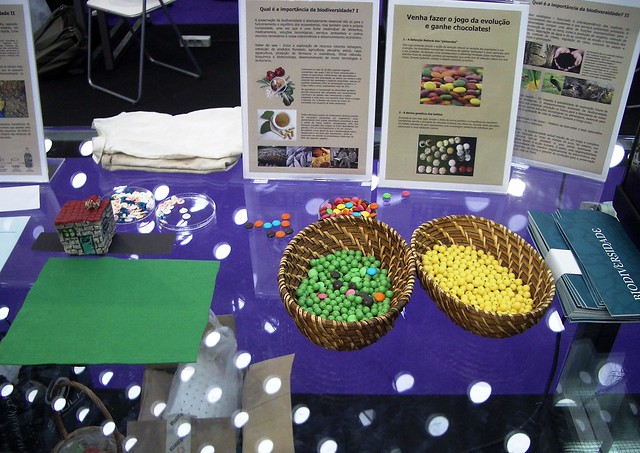
Participação do CIBIO na 8ª Mostra de Ciência, Ensino e Inovação da Universidade do Porto.
...
CIBIO was present in the 8th Exhibition of Science, Education and Inovation from the Universidade of Porto with some activities about evolution.